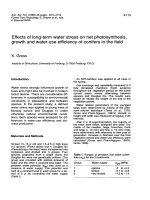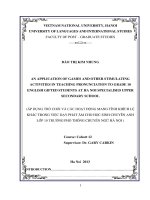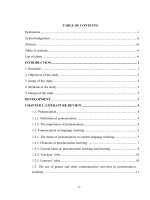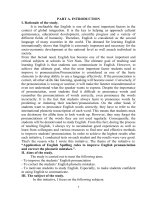Application of micro-irrigation and micro-nutrients to improve fibre yield and water use efficiency in sisal (Agave sisalana Perr. Ex Engelm.)
Bạn đang xem bản rút gọn của tài liệu. Xem và tải ngay bản đầy đủ của tài liệu tại đây (205.52 KB, 8 trang )
Int.J.Curr.Microbiol.App.Sci (2018) 7(10): 2101-2108
International Journal of Current Microbiology and Applied Sciences
ISSN: 2319-7706 Volume 7 Number 10 (2018)
Journal homepage:
Original Research Article
/>
Application of Micro-Irrigation and Micro-Nutrients to Improve Fibre
Yield and Water Use Efficiency in Sisal (Agave sisalana Perr. Ex Engelm.)
D.K. Kundu1*, S. Sarkar1, A.R. Saha1, A.K. Jha2 and M.S. Behera1
1
Crop Production Division, ICAR-Central Research Institute for Jute and Allied Fibres,
Nilgunj, Barrackpore, Kolkata-700120, India
2
Sisal Research Station, ICAR-CRIJAF, Bamra, Sambalpur, Odisha, India
*Corresponding author
ABSTRACT
Keywords
Sisal, Agave sisalana,
Micro-irrigation, Micronutrient, Yield, Water use
efficiency
Article Info
Accepted:
15 September 2018
Available Online:
10 October 2018
Field experiment was conducted during 2011-2015 at Sisal Research Station (22.041°N,
84.295°E, 267 m above mean sea level, AMSL), Bamra, Odisha, India to study the effect
of drip-irrigation and micronutrients (Zn and B) on growth, fibre yield, water use
efficiency, nutrient and micronutrient content in sisal (Agave sisalana Perr. Ex Engelm.). It
was observed that interaction of drip-irrigation @ 4 l/hr for 2 hrs at 2 weeks interval during
14-23 standard meteorological week (SMW) x micronutrients (zinc sulphate @ 20 kg +
borax 15 kg/ha) produced the longest leaf (97.2.cm) and produced the maximum number
of leaves (139.87 x 103) in sisal. The maximum fibre yield was recorded either with dripirrigation @ 4 l/ha for 4 hrs at 2 weeks interval during 14-23 SMW together with zinc
sulphate 20 kg/ha + borax 15 kg/ha (1546 kg/ha), or with drip-irrigation @ 4 l/hr for 2 hrs
at 2 weeks interval during 14-23 SMW together with zinc sulphate 20 kg/ha + borax 15
kg/ha (1493 kg/ha). Application of micronutrients (zinc sulphate 20 kg + borax 15 kg/ha)
together with drip-irrigation (4 l/hr for 2 hours at 2 weeks interval during 14-23 SMW)
gave the highest water use efficiency (4.52 kg/ha-mm). Water use efficiency reduced if the
drip-irrigation (4 l/hr at 2 weeks interval during 14-23 SMW) was prolonged for 4 hours
(3.46 kg/ha-mm). The highest Zn content (19.3 ppm) was recorded in treatments where
zinc sulphate (@ 20 kg/ha) together with borax (@ 15 kg/ha) was applied to soil. Similarly
the highest B content (14.4 ppm) was also observed in zinc sulphate (@ 20 kg/ha) + borax
(@ 15 kg/ha) applied cases.
Introduction
The
important
xerophytic
plant
of
Asparagaceae family is sisal (Agave sp) from
which commercial hard fibre is produced from
its long leaf. Several species of Agaves are
cultivated, among which A. sisalana, A.
cantala, A. vera-cruz, A. amaniensis, A.
angustifolia, A. fourcryodes are commercially
important (Sarkar and Jha, 2017). However, A.
sisalana contributes nearly 80-85% of the total
sisal fibre production of the World. Western
Odisha, Jharkhand, Chhattisgarh, and areas of
Maharashtra, Andhra Pradesh and Karnataka
are the important sisal growing zones of India.
India’s sisal fibre productivity is only 600-700
kg/ha due to age old cultivation practices and
other concerned reasons. Considerable amount
2101
Int.J.Curr.Microbiol.App.Sci (2018) 7(10): 2101-2108
of sisal fibre is imported by India from Brazil,
Tanzania, Madagascar and other sisal growing
countries as the native total production is not
sufficient to meet the country’s internal need
(Sarkar, 2015). So, it is necessary to increase
productivity and total production of sisal fibre
in India. It is known that sisal can thrive
without irrigation as evidenced by the higher
concentration biochemical indicator of
drought such as proline (4.26 µg/g) when
exposed to drought stress (Riaz et al., 2016);
but it was also found in some field trial that
sisal responds well to irrigation and increased
fibre yield was obtained in India (Saha, 2001).
The water requirement of sisal (WR ≈ ETc or
Crop evapotranspiration under standard
condition) was estimated to be 550-800 mm
considering Kc (Crop coefficient 0.4-0.7,
depending upon plant density and water
management) and maximum crop height of
1.5 m (Anonymous 1992; Anonymous, 2002).
During 14-22 standard meteorological week
(SMW; 2 April to 3 June) the total rainfall in
western Odisha is only 38.57 mm from 2.5
rainy days and in 23rd SMW the rainfall is
39.89 mm for 2 rainy days due to initiation of
monsoon (Sarkar et al., 2013). Although the
Kc value for sisal (0.4-0.7) is quite low as
compared to other important fibre crops such
as cotton (Kc 1.15-1.20) and flax (Kc 1.10),
but during this dry spell (14-23 SMW) dripirrigation might be beneficial for sisal. The
soils of most of the sisal growing tracts of
central plateau zone of India are acidic in
reaction and deficient in micronutrients such
as Zn and B. Moreover, Pinkerton (1971)
reported that deficiency of Zn and B (together
with some other micronutrients) affected leaf
length, rate of unfurling of leaf and leaf
elongation rate which ultimately affected fibre
yield and quality of sisal fibre in Kenya. But
such work on micronutrients has not so far
been conducted for Indian sisal producing
areas. In view of the scanty information on
these
aspects
(micro-irrigation
and
micronutrients) of sisal crop management in
India, field experiment was conducted at Sisal
Research Station, Bamra, Odisha to study the
effect of drip-irrigation and micronutrients (Zn
and B) on the fibre yield, and water use
efficiency in sisal.
Materials and Methods
A field experiment was conducted during
2011-2015 at the Sisal Research Station
(located at 22.041°N, 84.295°E, 267 m
AMSL) a regional research station of ICARCRIJAF, at Bamra, in Sambalpur district of
Odisha, India to study the effect of dripirrigation, and micronutrients (Zn & B) on
fibre yield, and water use efficiency in sisal.
Soil at the experimental site belongs to
typicochraqualf and was acidic in reaction
with pH (1:2.5 w/v) in water 5.1, low in
organic carbon 4.4 g/kg, having available N
226 kg/ha, available P 4.9 kg/ha and available
K 168 kg/ha. The experiment was laid in 2
factor split plot design with 3 levels of
irrigation (I1= no irrigation; I2: drip irrigation
with discharge rate of 4 l/hr for 2 hours at 2
weeks intervalduring 14-23 SMW; I3: drip
irrigation with discharge rate of 4 l/hr for 4
hours at 2 weeks intervalduring 14-23 SMW)
in main plot and 4 levels of micronutrients
[M1= no micronutrient;M2=Zn as zinc
sulphate @ 20 kg/ha in soil;M3= B as borax @
15 kg/ha in soil; and M4= Zn as zinc sulphate
@ 20 kg/ha + B as borax @ 15 kg/ha in soil]
in sub plots with individual plot size of 10 m x
3 m replicated thrice. Irrigation treatment was
applied through drip method and the drip
system was installed in the experimental plot
with one nozzle near the base of each sisal
plant so that irrigated water could be applied
to the plants efficiently and economically.
Healthy suckers of sisal were planted in the
recommended double row planting system
[(1m x 1m) x 3 m] in the month of July, 2011.
Other standard recommended agronomic
practices were followed to raise the
experimental sisal plantation. Leaves were
2102
Int.J.Curr.Microbiol.App.Sci (2018) 7(10): 2101-2108
harvested from the plants after 2½ years of
planting. Leaf harvesting continued for
consecutive 2 years in the winter season
(December-January) of 2013-14 and 2014-15.
The harvested leaves were carried to the
extraction site and fibres were extracted with
diesel operated sisal decorticator machine of 5
HP capacity. The biometric field data of crop
and laboratory data of plant and soil samples
were processed and analysed by statistical
software IBM SPSS Statistics v. 24.
application of 20 kg zinc sulphate + 15 kg
borax produced the maximum number of
leaves (139.51 x 103). Interaction effect of I2
(drip-irrigation @ 4 l/hr for 2 hrs at 2 weeks
interval) x M3 (borax @ 15 kg/ha) produced
the maximum number of leaves (139.87 x
103). Similar result of more harvested leaves
due to micro-irrigation was also reported
earlier (Kundu et al., 2013). More number of
harvested leaves resulted higher fibre yield of
sisal (Sarkar et al., 2017).
Results and Discussion
Effect of drip-irrigation and micronutrients
on total weight of harvested leaves
Effect of drip-irrigation and micronutrients
on leaf length of sisal at harvest
Irrespective of micronutrient levels, dripirrigation at a discharge rate of 4 l/hr for 4 hrs
at 2 weeks interval (I4) produced the longest
leaves (90.0 cm), followed by the leaf length
(86.9 cm) obtained with I3 (drip-irrigation @ 4
l/hr for 4 hrs at 2 weeks interval (Table 1).
Irrespective of irrigation levels, Zn (zinc
sulphate 20 kg/ha) together with B (borax 15
kg/ha) produced the longest leaves (90.6 cm).
In interaction mode, I3 (drip-irrigation @ 4
l/hr for 2 hrs at 2 weeks interval) x M4 (zinc
sulphate @ 20 kg + borax 15 kg/ha) produced
the longest leaf of sisal (97.2.cm). It is well
established that longer leaves of sisal directly
contribute to the higher fibre yield in sisal
(Sarkar et al., 2017). Nobel et al., (1988)
reported that application of B @ 10 kg/ha
(together with N, P, K) enhanced growth of
Agave in California.
Effect of drip-irrigation and micronutrients
on number of harvested leaves
Either I2 (drip-irrigation @ 4 l/hr for 2 hrs at 2
weeks interval) or I3 (drip-irrigation @ 4 l/ha
for 4 hrs at 2 weeks interval) singly, produced
the maximum number of harvestable leaves
134.27 x 103 and 138.43 x 103, respectively
(Table 2). Irrespective of irrigation levels,
Irrespective of micronutrient levels, I2 (dripirrigation @ 4 l/hr for 2 hrs at 2 weeks
interval) and I3 (drip-irrigation @ 4 l/ha for 4
hrs at 2 weeks interval) produced the
maximum weight of harvested leaves of 31.75
and 34.15 t/ha, respectively (Table 3). While
comparing different levels of micronutrients
alone, it was recorded that the M4 (zinc
sulphate @ 20 kg + borax @ 15 kg/ha)
produced the highest harvested leaf weight
(34.57 t/ha). In interaction, I2 (drip irrigation
@ 4 l/ha for 2 weeks at 2 weeks interval) x M4
(zinc sulphate @ 20 kg and borax @ 15 kg/ha)
and I3 (drip-irrigation @ 4 l/ha for 2 weeks
interval) x M4 gave the highest weight of
harvested leaves of 37.33 and 38.31 t/ha,
respectively.
Effect of drip-irrigation and micronutrients
on fibre yield of sisal
Fibre yield of sisal differed significantly due
to application of drip-irrigation and
micronutrients individually or in combination
(Table 4). Irrespective of micronutrient levels,
drip-irrigation @ 4 l/ha for 4 hrs at 2 weeks
interval (I3) and drip-irrigation @ 4 l/hr for 2
hrs at 2 weeks interval (I2) produced the
highest fibre yield of 1393 and 1293 kg/ha,
respectively. Whereas, application of zinc
sulphate (20 kg/ha) together with borax (15
2103
Int.J.Curr.Microbiol.App.Sci (2018) 7(10): 2101-2108
kg/ha) produced the highest fibre yield of
1382 kg/ha. In interaction mode, the highest
fibre yield was recorded either with dripirrigation @ 4 l/ha for 4 hrs at 2 weeks
interval together with zinc sulphate 20 kg/ha +
borax 15 kg/ha (1546 kg/ha), or with dripirrigation @ 4 l/hr for 2 hrs at 2 weeks interval
together with zinc sulphate 20 kg/ha + borax
15 kg/ha (1493 kg/ha). The lowest fibre yield
was recorded with no-irrigation and no
micronutrient applied cases (786 kg/ha).
It was found that drip-irrigation (@ 4 l/ha for
4 hrs at 2 weeks interval) together with zinc
sulphate 20 kg + borax 15 kg/ha gave 1.97
times and drip-irrigation (@ 4 l/hr for 2 hrs at
2 weeks interval) together with zinc sulphate
20 kg + borax 15 kg/ha gave 1.90 times fibre
yield in sisal as compared to no-irrigation and
no micronutrient application. Application of
drip-irrigation alone increased the fibre yield
by 49.9% and application of micronutrients
(zinc sulphate 20 kg + borax 15 kg/ha) alone
couldincrease the fibre yield by 31.2% in
sisal.Earlier in Israel, the highest fibre yield of
sisal (978 kg/ha from 2222 plants) was
obtained with 252 mm irrigation (in addition
to 200 mm rainfall) applied in 2 irrigations
(Shalhevet et al., 1979). In recent past it was
reported that Agave americana crop reached
9.3 Mg dry mass/ha/year with 530 mm of
annual water inputs, including both rainfall
and irrigation (Davis et al., 2017). Besides
yield increase by drip-irrigation, it was
reported that drip-irrigation (@ 4 l/hr for 2 hrs
at 2 weeks interval) alone could produce
higher number of suckers (76.14 x 103) within
6 years, which is about 32.8% more as
compared to no-irrigation (Sarkar et al.,
2018).
Table.1 Effect of drip-irrigation and micronutrients on leaf length of sisal at harvest
Drip irrigation
Leaf length (cm)
Levels of micronutrients
I1
I2
I3
Mean
CD (5%)
M1
73.9
82.3
83.8
80.0
M2
M3
M4
76.6
77.6
80.7
85.1
86.4
93.9
88.7
90.4
97.2
83.5
84.8
90.6
I = 2.5; M = 4.1; I x M = 2.2
Mean
77.2
86.9
90.0
Table.2 Effect of drip-irrigation and micronutrients on number of harvested leaves
Drip irrigation
I1
I2
I3
Mean
CD (5%)
Number of leaves harvested (in thousand)
Levels of micronutrients
M1
112.80
128.00
129.47
123.42
M2
M3
M4
120.13
124.40
126.00
132.27
132.80
144.00
135.87
139.87
128.53
129.42
132.35
139.51
I = 4.90; M = 2.61; I x M = 4.96
2104
Mean
120.83
134.27
138.43
Int.J.Curr.Microbiol.App.Sci (2018) 7(10): 2101-2108
Table.3 Effect of drip-irrigation and micronutrients on total weight of harvested leaves
Drip irrigation
Weight of harvested leaves (t/ha)
Levels of micronutrients
M2
M3
M4
23.33
25.04
28.07
30.12
31.15
37.33
34.00
35.55
38.31
29.15
30.58
34.57
I = 3.72; M = 2.65; I x M = 3.55
M1
20.91
28.38
28.73
26.01
I1
I2
I3
Mean
CD (5%)
Mean
24.34
31.75
34.15
Table.4 Effect of drip-irrigation and micronutrients on fibre yield of sisal
Drip irrigation
M1
786
1173
1200
1053
I1
I2
I3
Mean
CD (5%)
Fibre yield (kg/ha)
Levels of micronutrients
M2
M3
M4
880
946
1106
1226
1280
1493
1400
1426
1546
1169
1217
1382
I = 105; M = 99; I x M = 77
Mean
929
1293
1393
Table.5 Effect of drip-irrigation and micronutrients on water use efficiency of sisal
Irrigation levels
I1 (CU= 258.5 mm)
I2 (CU= 330.6 mm)
I3 (CU= 402.6 mm)
Mean (CU= 330.6 mm)
Water use efficiency (kg fibre/ha-mm water)
Levels of micronutrients
M1
M2
M3
M4
Mean
3.04
3.40
3.66
4.28
3.60
3.55
3.71
3.87
4.52
3.91
2.98
3.48
3.54
3.84
3.46
3.18
3.53
3.68
4.18
CU = Consumptive use of water
Table.6 Effect of drip-irrigation and micronutrients on major nutrient content in leaves
Irrigatio
n
I1
I2
I3
N (%)
M1
0.9
7
1.1
0
1.2
1
M2
0.9
9
1.2
5
1.3
2
M3
1.0
0
1.2
3
1.3
0
M4
1.0
8
1.2
6
1.3
5
P (%)
Levels of micronutrients
M1
M2
M3
M4
M1
0.10 0.12 0.12 0.12 0.55
8
0
4
8
4
0.13 0.14 0.16 0.16 0.65
5
0
9
8
0
0.13 0.18 0.18 0.20 1.21
7
2
5
9
0
2105
K (%)
M2
1.01
2
1.16
4
1.65
0
M3
1.67
6
1.76
0
1.91
4
M4
1.18
8
1.51
8
1.67
2
Int.J.Curr.Microbiol.App.Sci (2018) 7(10): 2101-2108
Table.7 Effect of drip-irrigation and micronutrients on Zn and B content in sisal leaves
Irrigation
I1
I2
I3
Zn (ppm)
M1
2.0
2.1
2.1
M2
14.8
15.5
16.2
M3
2.3
2.7
2.8
B (ppm)
Levels of micronutrients
M4
M1
M2
17.0
3.7
4.1
19.2
4.0
4.4
19.3
4.2
4.6
Effect
of
drip-irrigation
and
micronutrients on water use efficiency in
sisal
Irrespective
of
micronutrients
levels,
application of drip-irrigation @ 4 l/hr for 2
hrs at 2 weeks interval resulted the highest
water use efficiency in sisal (3.91 kg/ha-mm)
(Table 5). The value of water use efficiency
reduced if the drip-irrigation (4 l/hr at 2
weeks interval) was prolonged for 4 hours
(3.46 kg/ha-mm). Davis et al., (2017)
reported that water use efficiency in sisal
declined in treatments with greatest water
input (780 mm/year). Application of
micronutrients (zinc sulphate 20 kg + borax
15 kg/ha) together with drip-irrigation (4 l/hr
for 2 hrs at 2 weeks interval) gave the highest
water use efficiency (4.52 kg/ha-mm).
It was recorded that incorporation of
micronutrients (zinc sulphate 20 kg + borax
15 kg/ha) in drip-irrigation treatment (4 l/hr
for 2 hours at 2 weeks interval) could improve
the water use efficiency by 15.6% in sisal. In
Israel, the water use efficiency in sisal
obtained was 3.55, 3.22 and 1.07 kg fibre/hamm from one, two and eight irrigations,
respectively (Shalhevet et al., 1979). Earlier
Mekonnen and Hoekstra (2011) reported that
the blue water footprint (volume of surface
and ground water consumed for production of
crop) for sisal fibre is only 9 m3/t, which is
considerably less than the blue water footprint
for jute (33 m3/t), ramie (201 m3/t) and flax
fibre (443 m3/t). FAO also opined that sisal
requires relatively small amount of water and
M3
12.9
13.8
14.2
M4
13.5
14.2
14.4
excess water will negatively affect yield
(Anonymous, 1992).
Effect
of
drip-irrigation
and
micronutrients on major nutrient content
in sisal leaves
The highest nitrogen (N) content was
recorded in drip-irrigation (@ 4 l/hr for 4 hrs
at 2 weeks interval) and micronutrients (zinc
sulphate 20 kg + borax 15 kg/ha) applied
plots (1.35 % N) (Table 6). Similarly, the
highest phosphorus (P) content in leaf was
obtained in drip-irrigation (@ 4 l/hr for 4 hrs
at 2 weeks interval) and micronutrients (zinc
sulphate 20 kg + borax 15 kg/ha) treatments
(0.209% P). However, the maximum
potassium (K) content was recorded in dripirrigation (@ 4 l/hr for 4 hrs at 2 weeks
interval) and borax (15 kg/ha) applied cases
(1.914% K). Drip-irrigation alone could
increase the leaf N content by 16.4%, P
content by 50% and K content by 45% in sisal
as compared to no-irrigation treatment.
Effect
of
drip-irrigation
and
micronutrients on Zn and B content in sisal
leaves
Drip-irrigation has not exerted any significant
effect on micronutrient content (Zn & B) in
sisal leaves. It was observed that soil
application of Zn as zinc sulphate (@ 20
kg/ha) increased the Zn content and
application of B as borax (@ 15 kg/ha) in soil
enhanced the B content in sisal leaves (Table
7). The highest Zn content (19.3 ppm) was
2106
Int.J.Curr.Microbiol.App.Sci (2018) 7(10): 2101-2108
recorded in treatments where zinc sulphate
(@ 20 kg/ha) together with borax (@ 15
kg/ha) was applied in soil. Similarly the
highest B content (14.4 ppm) was also
observed in zinc sulphate (@ 20 kg/ha) + with
borax (@ 15 kg/ha) applied cases. Similar
observations of Zn and B (together with other
micronutrients viz. Mn, Cu, Fe and Mo) were
recorded in Kenyan soil in sisal cultivation
(Pinkerton, 1971). It was interesting to note
that the Zn concentration was lower in cases
where B was not applied. Deficiency of B
decreased Zn concentration by 12.94 to
19.27% in sisal leaves. Similar report
Pinkerton (1971) mentioned that deficiency of
boron (and copper) depressed Zn uptake by
sisal in Kenya.
From the field experiment it may be
concluded that application of drip-irrigation
@ 4 l/hr for 2 hrs at 2 weeks interval during
14-23 SMW) together with micronutrients
(zinc sulphate @ 20 kg + borax 15 kg/ha)
could produce the longest leaf (97.2.cm) and
maximum number of harvestable leaves
(139.87 x 103) in sisal. For obtaining
maximum fibre yield in sisal, application of
either drip-irrigation @ 4 l/ha for 4 hrs at 2
weeks interval during 14-23 SMW together
with zinc sulphate 20 kg/ha + borax 15 kg/ha
(1546 kg/ha), or with drip-irrigation @ 4 l/hr
for 2 hrs at 2 weeks interval together with
zinc sulphate 20 kg/ha + borax 15 kg/ha
(1493 kg/ha) are suggested. Application of
micronutrients (zinc sulphate 20 kg + borax
15 kg/ha) together with drip-irrigation (4 l/hr
for 2 hours at 2 weeks interval during 14-23
SMW) gave the highest water use efficiency
(4.52 kg/ha-mm) in sisal. Water use
efficiency is reduced if the drip-irrigation (4
l/hr at 2 weeks interval) was prolonged for 4
hours (3.46 kg/ha-mm). Application of
micronutrients such as Zn and B are
suggested for sisal grown in the central
plateau zone of India, as the highest Zn
content (19.3 ppm) was recorded in
treatments where zinc sulphate (@ 20 kg/ha)
together with borax (@ 15 kg/ha) was applied
in soil. Similarly the highest B content (14.4
ppm) was also found in zinc sulphate (@ 20
kg/ha) + with borax (@ 15 kg/ha) applied
cases.
References
Anonymous. 1992. Crop water requirements.
FAO irrigation and drainage paper 24.
Food and Agricultural Organization of
UNO, Rome.
Anonymous. 2002. Crop water requirement
and irrigation scheduling. Irrigation
Manual Module 4. Food and
Agricultural Organization of UNO,
Rome.
Davis, S.C., Kuzmick, E.R., Niechayev, N.
and Hunsaker, D.J. 2017. Productivity
and water use efficiency of Agave
Americana in the first field trial as
bioenergy feed store on arid lands.
Global Change Biology Bioenergy, 9:
3140325.
Kundu, D.K., Sarkar, S., Saha, A.R., Jha,
A.K. and Abdullah, Sk. 2013. Growth
and fibre yield of sisal as influenced by
irrigation
and
application
of
micronutrients. JAF News, 11 (1): 1314.
Mekonnen, M.M. and Hoekstra, A.Y. 2011.
The green, blue and grey water footprint
of crops and derived crop products.
Hydrology and Earth System Sciences,
15: 1577-1600.
Nobel, P.S., Quero, E. and Linares, H. 1988.
Differential growth response of Agaves
to nitrogen, phosphorus, potassium and
boron applications. Journal of Plant
Nutrition, 11 (12): 1683-1700.
Pinkerton, A. 1971. Some micronutrient
deficiencies in sisal (Agave sisalana).
Experimental Agriculture, 7: 113-122.
Riaz, S., Aftab, B., Sarwar, M.B., Batool, F.,
Iqbal, F., Ahmed, Z., Rashid, B. and
2107
Int.J.Curr.Microbiol.App.Sci (2018) 7(10): 2101-2108
Husnain, T. 2016. Adaptations of plant
responses in Agave sisalana under
drought stress conditions. Journal of
Biodiversity
and
Environmental
Sciences, 9 (4): 114-123.
Saha, A.R. 2001. Assessment of yield
potential and effect on life span of
Agave sisalana and Bamra Hybrid
under irrigated and rainfed condition.
CRIJAF Annual Report, 2000-2001; pp
117-118.
Sarkar, S. 2015. Sisal: Its scope as a multidimensional fibre crop for India. Indian
Farming, 65 (5): 2-7.
Sarkar, S. and Jha, A.K. 2017. Research for
sisal (Agave sp.) fibre production in
India. International Journal of Current
Research, 9 (11): 61136-61146.
Sarkar, S., Jha, A.K., Majumdar, B. and Saha,
A.R. 2018. Influence of drip-irrigation,
manure and fertilizers on production of
planting materials in sisal (Agave
sisalana
Perr.
Ex
Engelm.).
International Journal of Current
Microbiology and Applied Sciences, 7
(9): 1934-1941.
Sarkar, S., Kundu, D.K. and Mahapatra, B.S.
2013. Rainfall probability analysis of
the western Odisha plateau region for
sisal (Agave sisalana Perrine ex
Engelm.) based cropping system.
Journal of Agricultural Physics, 13 (1):
62-70.
Sarkar, S., Saha, A.R. and Majumdar, B.
2017. Fibre yield estimation in sisal
(Agave sisalana Perr. Ex Engelm.)
through regression equation based on
simple
biometric
observations.
International Journal of Current
Research, 9 (3): 47853-55.
Shalhevet, J., Mantell, A., Bielorai, H. and
Shimshi, D. 1979. Irrigation of field and
orchard
crops
under
semi-arid
conditions. IIIC Publication No. 1,
International Irrigation Information
Centre, at Agricultural Research
Organization, Volcani Centre, Volcani,
Israel, p 124.
How to cite this article:
Kundu, D.K., S. Sarkar, A.R. Saha, A.K. Jha and Behera, M.S. 2018. Application of MicroIrrigation and Micro-Nutrients to Improve Fibre Yield and Water Use Efficiency in Sisal
(Agave sisalana Perr. Ex Engelm.). Int.J.Curr.Microbiol.App.Sci. 7(10): 2101-2108.
doi: />
2108









